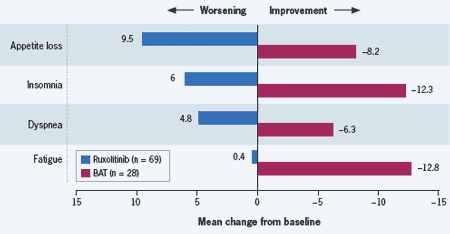Investigational Agent Provides Hope for Patients With Myelofibrosis
Treating myelofibrosis with the investigational JAK inhibitor ruxolitinib holds promise.

Alessandro Maria Vannucchi, MD
Treating myelofibrosis with the investigational JAK inhibitor ruxolitinib holds promise, according to the phase III Controlled Myelofibrosis Study with Oral JAK Inhibitor Treatment (COMFORT-II) trial results presented in June at the ASCO meeting.
COMFORT-II compared ruxolitinib with the best available therapy and showed that ruxolitinib significantly reduced spleen size and volume (P <.0001) compared with the best available therapy. Ruxolitinib also reduced symptom burden and improved quality-of-life (QOL), said one of the study’s authors, Alessandro Maria Vannucchi, MD, of the University of Florence in Italy, who presented the results.
Myelofibrosis, a disorder of the bone marrow that can be primary or secondary, is characterized by dysregulation of JAK-STAT signaling and, therefore, is a theoretically attractive therapeutic target. Phase I/II trials showed good activity for JAK inhibition with ruxolitinib and the present study, as well as the placebo-controlled COMFORT-I study, were based on that observation. Other JAK inhibitors in various stages of development are also being studied in myelofibrosis.
COMFORT-II was an open-label trial that enrolled 219 patients with intermediate-2 or highrisk primary myelofibrosis, post-polycythemia vera myelofibrosis, or post-essential thrombocythemia myelofibrosis. Patients were randomized in a 2:1 ratio to ruxolitinib 15 or 20 mg twice a day or to best available therapy and were treated for 48 weeks. One-quarter of patients assigned to best available therapy crossed over to ruxolitinib for disease progression.
Table. COMFORT-II Trial: Percent Change from Baseline in Spleen Volume
Ruxolitinib
BAT
Decrease in spleen volume
132 (97%)
35 (56%)
Increase in spleen volume
4 (3%)
28 (44)
BAT indicates best available therapy.
Adapted from Harrison et al. J Clin Oncol. 2011;29(suppl;abstr LBA6501).
In the control arm (best available therapy), 67% of patients were treated with at least 1 medication, but the remaining one-third was not treated. Hydroxyurea was given to 47% of those who got medication; glucocorticoids were given to 16% of that group.
The percentage of patients who met the primary endpoint (ie, at least 35% shrinkage in spleen volume at week 48) was 28.5% for ruxolitinib versus 0% for best available therapy (P <.0001) (Table). Median time to response was 12 weeks.
Reduction in spleen volume was accompanied by marked improvement on QOL measures seen at week 8 through the end of treatment. However, no improvement in QOL was observed in the best-available-therapy arm (Figure).
Figure. COMFORT-II Trial: Change in Select EORTC QLQ-C30 Scores at Week 48 Compared With Baseline

BAT indicates best available therapy.
Adapted from Harrison et al. J Clin Oncol. 2011;29(suppl;abstr LBA6501).
Ruxolitinib is associated with myelosuppression, which was observed to a lesser extent in the control arm as well. At baseline, about 60% of patients had anemia, and grade 3/4 anemia was reported in 42% of the experimental arm versus 31% of controls. More patients in the ruxolitinib arm required transfusions: 51% versus 38%, respectively.
No survival benefit has emerged but followup was short.
At the same session, COMFORT-I results were announced. In this randomized, placebocontrolled arm with the same enrollment criteria as COMFORT-II, at a median follow-up of 32 weeks, 41.9% of the ruxolitinib-treated patients versus 0.7% of the placebo group achieved the primary endpoint (ie, at least 35% shrinkage in spleen volume at week 24) (P <.0001). Symptom burden was also significantly improved (P <.0001) with ruxolitinib versus placebo. More thrombocythemia and anemia were observed in the ruxolitinib arm.
Investigators of both trials were enthusiastic about these results, especially QOL improvements.
Harrison CN, Kiladjian J, Al-Ali HK, et al. Results of a randomized study of the JAK inhibitor ruxolitinib (INC424) versus best available therapy in primary myelofibrosis, post-polycythemia vera-myelofibrosis or post-essential thrombocythemia-myelofibrosis. J Clin Oncol. 2011;29(suppl; abstr LBA6501).
Verstovsek S, Mesa RA, Gotlib JR, et al. Results of COMFORT-I, a randomized double-blind phase III trial of JAK 1/2 inhibitor INCB18424 versus placebo for patients with myelofibrosis. J Clin Oncol. 2011;29(suppl; abstr 6500).




